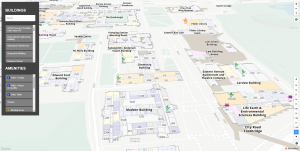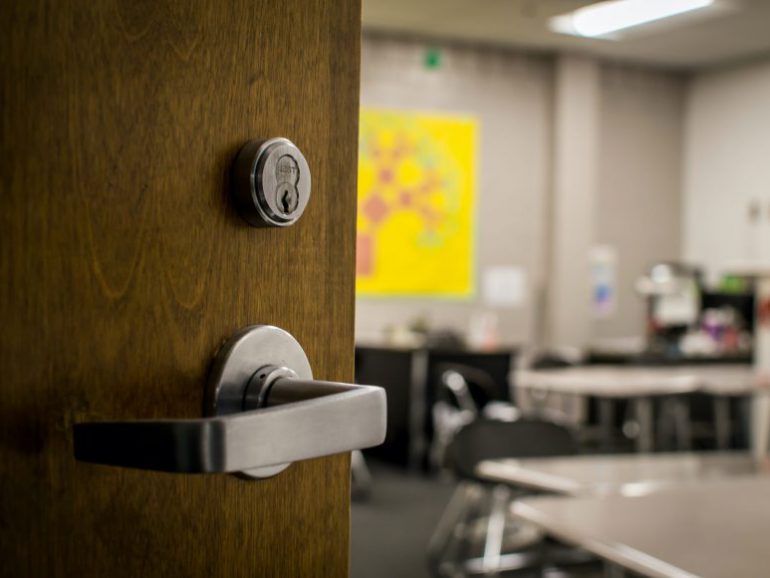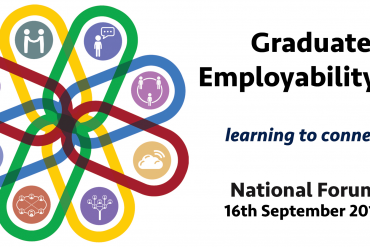This semester, most of us will be heading back into the physical classroom. It’s an exciting time, but may be a bit unfamiliar for many of us who have been away from campus for a while. Here’s a few quick tips, and you can also download the tips below in a handy one-pager PDF.
Before semester starts
-

Screenshot of the new internal navigation map. Help your students transition back to learning differently. Most students have had a disrupted 2 years of learning. Help them to ‘learn after lockdown‘ by demystifying how different classes work and what to expect: what’s a tutorial, why are they important, and where do students go? Campus is a big place; link to the campus maps page – there are now even maps for indoor navigation!
- Make your Canvas site homely. Have a welcoming front page (complete with pictures or even a video of yourself), FAQs, and a welcome announcement.
- Plan for what happens if students are sick or isolating and unable to attend class. Think about the best plan for what to do when this happens – can students catch up asynchronously after class (e.g. with a recording and resources), or will it be possible to have them Zoomed-in by a classmate, or perhaps you might need to teach in HyFlex?
-

Photos of almost all University teaching venues are available online. Check out the tech available in your teaching room. Find your teaching space in this directory that outlines information about all rooms on all campuses. Know about accessibility options, audio-visual equipment, and room capacity and see pictures of the space to help you plan teaching activities. You can also ask for 15 minute intro sessions with ICT’s AV team.
- Check your class recording settings. We are used to teaching through Zoom, but Echo360 may still be active in your teaching venue, leading to duplicate recordings. Check out this guide to fix it.
In your first class

- Help everyone learn names. Try name tents for the first few weeks, and try handing them out yourself by week 3.
- Acknowledge the trauma of 2 years of COVID. You might like to encourage the class to share one thing they have each learned about themselves during COVID or practice gratitude, which increases resilience. To kick things off, share yours first. Or try an easy values affirmation activity to help students refocus on what they consider important. Trauma affects how students engage, and some students may have experienced serious trauma (death, illness, etc).
- Know how to get AV help. If there are unexpected issues with audiovisual technology, ICT prioritises “class in-progress” issues. Call the Shared Service Centre on 9351 2000 (or extension 12000 from internal phones) to get specialist support. Check out other guides on the AV support page.
Over the first few weeks of semester
- Set some class norms. In the second or third class, help build psychological safety by working with students to develop some classroom norms that are relevant for your cohort and discipline. Check out a simple way to run this powerful activity.
- Keep encouraging student contributions. Design activities where students can contribute their ideas, opinions, and experiences in a safe and non-judgemental environment. Consider using some technology such as online polling tools or Padlet to help.
- Make the most of being together physically. Get students safely moving and interacting. Plan activities where students are working together in small groups e.g. using physical whiteboards or shared docs on their laptops to develop knowledge and ideas.
- Support students who disengage. As the government’s HELP funding changes hit, disengagement risks students’ access to this scheme. Consider how to best identify these students and reach out before census date. Also, provide links to support resources for students, which are nicely summarised on the Intranet.
- Leave buffer time in all classes. If the last two years have taught us anything, it’s to expect the unexpected. Whether it is technology failure, the strangeness of being back in person, or just the thrill of a runaway discussion, building in buffer time will reduce yours and your students’ stress.
- Keep being human. We (teachers and students alike) will all be readjusting to learning in person. Remember that there will be many traumas that we cannot observe. Let your students in and be upfront about your capacities and expectations. Be kind to your students, and be kind to yourself.





